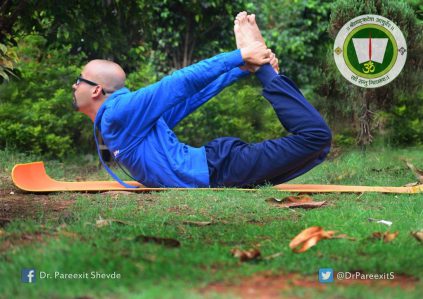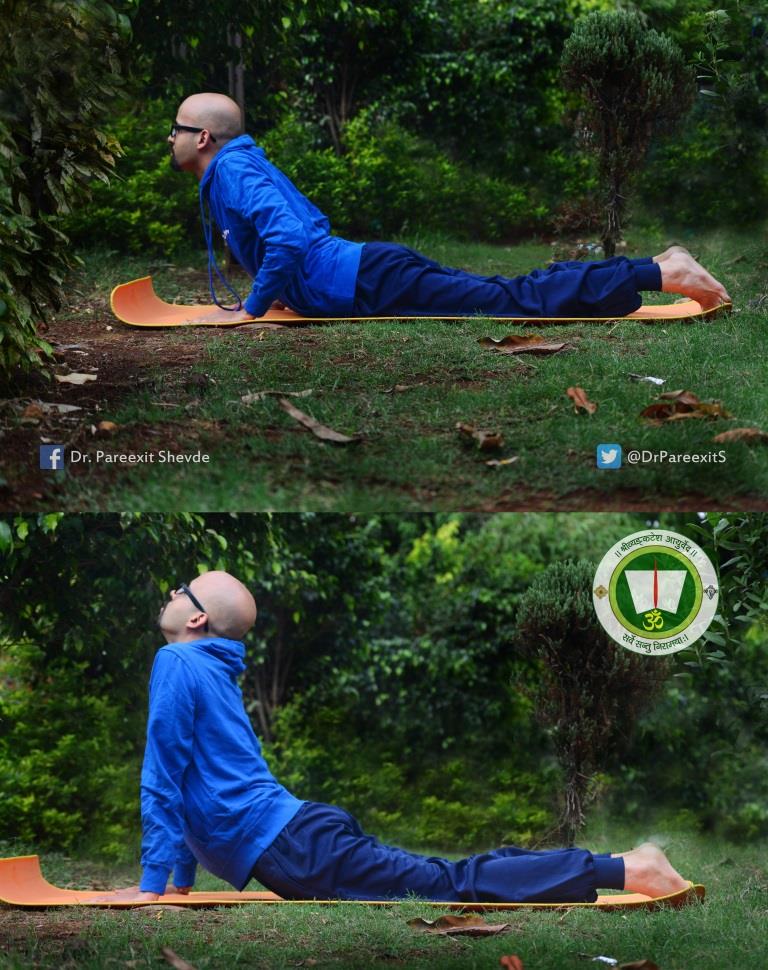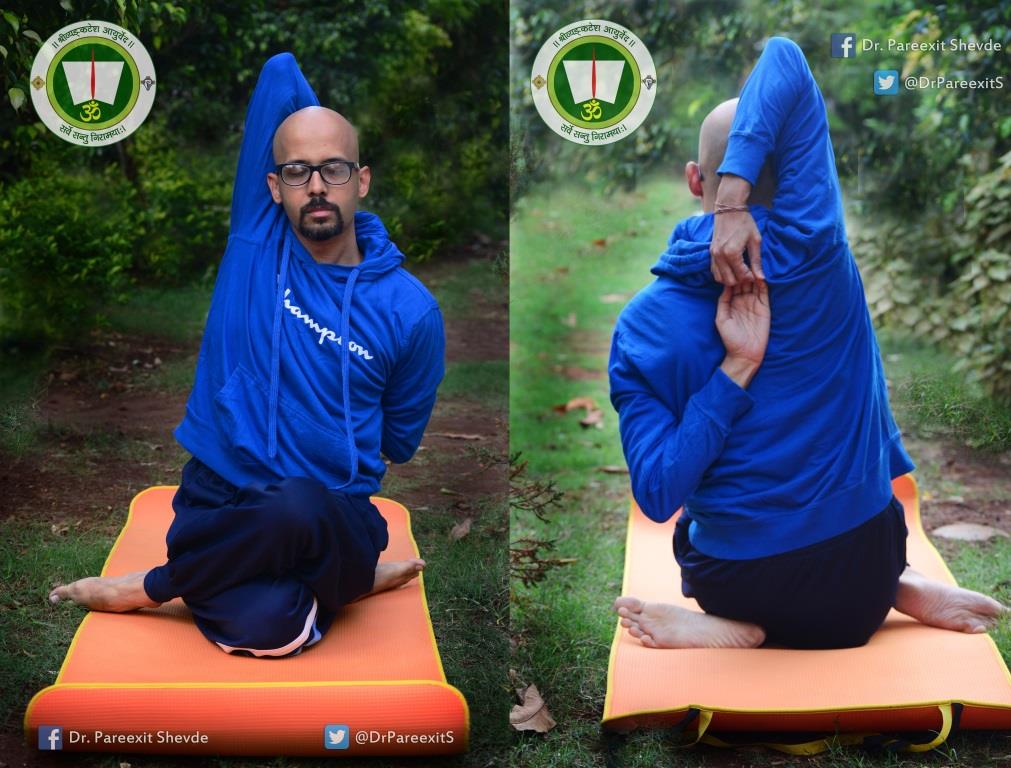Pavanmuktasana
Pavan means gas. This particular asana is very useful in order to bloating of abdomen and keep the digestion on track.
Position:
- Lie on your back with feet touching together and arms beside your body
- Breathe in and as you exhale, bring your right knee towards your chest and press the thigh on your abdomen with help of your hands
- Now lift your head and chest off the ground and touch your chin to your right knee. You can remain in this position for 10-15 secs and then come back to normal posture
- Repeat this pose with the left leg and then with both the legs together
- This can be done in set of five with each leg and later on with both the legs together
Benefits for ITans:
- Strengthens the muscles of back and abdomen
- Helps improving digestion and relieving bloating of abdomen
- Helps strengthening lower back
Avoid in case of:
Severe neck or back problems, heart problem, hyperacidity, hernia, pregnancy.
Sharing is caring!!
Dr. Pareexit Shevde; MD (Ayu)
Dhanurasana
Dhanu in Sanskrit is bow. In final posture of this asana; shape of vertebral column resembles to that of stretched bow hence the name.
Position:
- Lie flat on your stomach with your feet width apart and your arms kept by the side of body
- Fold your knees, take your hands backwards and hold your ankles
- Breathing in, lift your chest off the ground and pull your legs up and back pulling them with your hands; just like a bow is stretched
- Look straight ahead or simply close your eyes and breathe slowly
- Feel the stretch on your vertebral column as it gets curved like bow
- Maintain the posture for 15 -20 seconds, slowly bring your legs and chest to the ground while you exhale
- Don’t stretch yourself beyond limits; after constant practice you will be able to maintain the curve of vertebral column
Benefits for ITans:
- Strengthens the back and abdominal muscles
- Makes your vertebral column more flexible and corrects postural abnormalities
- Tones up thighs and calf muscles
- Useful for the health of reproductive organs
Avoid in case of:
Neck injury, abdominal or back surgery, pregnancy and lower backache.
Sharing is caring!!
Dr. Pareexit Shevde; MD (Ayu)

Bhujangasana
Bhujanga means cobra is Sanskrit. Final posture of this asana resembles a cobra with its hood raised; hence the name.
Position:
- Lie down flat on your stomach with your toes flat on the floor and forehead resting on the ground
- Keep your legs close together while feet and heels lightly touching each other
- Place your palms below the level of your shoulders, keeping your elbows parallel and close to your torso
- Taking a deep breath in, slowly lift your head, chest and abdomen while keeping your navel on the floor
- Pull your torso back with the firm support of your hands
- Keep breathing slowly in this postion, this is basic posture of Bhujangasana (Pic on top)
- In advanced position; slowly straighten your arms by pushing your back as much as possible; tilt your head back and look up. Make sure you don’t stretch your vertebral column beyond your capacity (Pic at the bottom)
- Remain in this positon for 10-15 secs. Beginners shouldn’t jump to advanced posture without sufficient practice of basic one
- Breathing out, gently bring your abdomen, chest and head back to the floor
Benefits for ITans:
- Improves flexibility of the upper, middle and lower back
- Strengthens the musculature of back, neck and shoulders
- Tones the abdomen resulting in reduction of the belly fat due to sedentary lifestyle
Avoid in case of:
Pregnancy, recent abdominal surgeries and fractured ribs or wrist etc.
Sharing is caring!!
Dr. Pareexit Shevde; MD (Ayu)

Gomukhasana
In Sanskrit language Go means the cow, Mukha means the face. In this asana; final posture resembles to the face of cow. Hence the name.
Position:
- Sit on the floor with both the legs extended in front of you
- Fold the left leg from knee joint and place it under the right buttock
- Fold the right leg, and place it on top of the left thighs
- The knees of both the legs should be one above the other and touching each other
- Fold your left arm and place it behind the back closely touching it to core. Keep your left palm near left scapula
- Extend your right arm over the right shoulder and then bend it from elbow. Now place it on the back as far as it can go
- Now try to hold both the hands behind the back. Initially it may be difficult and you may be able to just touch the fingers. Over the period and with constant practice one can achieve this position
- Keep your core and trunk straight and erect. Breathe slowly, observe the rhythm.
Maintain this position for 10 -15 secs
Benefits for ITans:
- Helps to make the backbone strong and flexible
- Removes stiffness in neck and shoulders especially the one caused due to constant use of computer mouse
- Helps in conditions like sciatica pain
Avoid in case of:
Severe back injury.
Sharing is caring!!
Dr. Pareexit Shevde; MD (Ayu)

Ushtrasana
Ushtra means Camel. The final posture resemble to hump on camel back hence the name. This is just opposite to Shashakasana and this is one of the backward bending Yoga asana for strengthening the back and spine.
Position:
- Kneel down and sit on your heels. Keep the knees and heels slightly apart
- Now raise yourself up on the knees. The core becomes perpendicular to ground in this pose
- Stretch your hands backwards and slowly bend your head and back with chin raised
- Continue the stretch, till your hands can feel the heels of your feet. Rest your hands on the heels
- Those who can’t stretch both the arms at a time can do it one by one
- To release the position, inhale and come back to the kneeling position
Benefits for ITans:
- This asana gives a good stretch to the muscles of back, chest, hips, groins and neck and is helpful for back pains, stooping shoulders and also for correcting postural defects of the spine due to sedentary lifestyle
- It tones the digestive, excretory and reproductive organs
- Ushtrasana improves the flexibility of the spine
Avoid in case of:
Vertigo, Serious neck injury and heart issues.
Sharing is caring!!
Dr. Pareexit Shevde; MD (Ayu)
Vajrasana
Various meanings of the word Vajra are diamond, weapon of lord Indra or Genitals. Regular practice of the same makes you stronger in core hence the name. Vajrasana is the only asana which can be practiced after food intake. In fact; that’s the preffered time for this asana.
Position:
- Sit on the flat floor stretching your legs away from body
- Fold your legs and keep your soles below your buttocks
- Keep the spine straight and close the eyes
- Keep both the palms resting on respective knees
- Breathe slowly and observe the breathing pattern
- Concentrate on your abdomen while performing this asana
- Come back to original potion after 4-5 minutes and repeat
Benefits for ITans:
- Calms the mind and bring stability in mind
- Due to lack of physical exercise, sedentary lifestyle and improper diet habits; IT professionals generally suffer with problems like indigestion, constipation, acidity etc. This asana helps curing them
- Helps to get rid of back pain
- Strengthens the sexual organs which again is an issue of concern for these professionals
- Strengthens the thigh muscles
Avoid in case of:
Hernia, intestinal ulcers and other diseases of the small and large intestine, surgery related to gastrointestinal tract, knee joint disorders.
Sharing is caring!!
Dr. Pareexit Shevde; MD (Ayu)
Shashakasana
Shashaka means hare. Final posture in this asana resembles to the hare; hence the name.
Position:
- To begin this pose, first sit in Vajrasana with both your palms should be placed on your knees. Distance in between knees should be more than Vajrasana
- Keep your neck and spinal cord straight
- While inhaling bring your hands above your shoulders without allowing the elbow to bend. Equal distance should be maintained between your arms with your fingers raised
- Slowly exhale and reach down to touch the ground with your head and both your hands. Relax when the forehead and palms touch the ground. Some areas of the chest and abdomen also rest on the thighs
- Let your upper torso relax and remain in this position for a while. Make sure that your arms remain flexed straight. The neck should also be kept straight between the arms
- To finish, come back to beginning position slowly
Benefits for ITans:
- Relaxes the nervous system
- Refreshes the brain and relieves depression, insomnia, and mental fatigue
- It improves concentration and memory
- Strengthens the pelvis, rib cage, back, and arms. It provides a good stretch to the back part of the body in the gluteal region, arms, back, neck, and shoulders
- Beneficial to the reproductive organs
Avoid in case of:
Vertigo, slipped disc, high blood pressure, and heart-related problems.
Sharing is caring!!
Dr. Pareexit Shevde; MD (Ayu)
Vrikshasana
Vriksha means tree. This posture is a replica of firm, graceful and steady stance of a tree.
Stand erects on the left leg, bend the right leg and place the right foot on the root of right thigh. Maintain the pose like as a tree on the ground. This is called vriksha-asana Gheranda-samhita II.36
Position:
- Stand straight. Keep the feet together
- Fold the right leg and placed it at the top of left thighs with the toes of right leg should pointed downwards and heel touching inguinal region
- The right leg should perpendicular to the left one. Extend your arms above your head; Inhale and perform Namaskar mudra
- Balance the pose as long as you can keeping eyes open and concentrating on a steady object
- Observe the stretching from toes to fingers while breathing slowly
- With deep exhale bring your arms and leg down
- Repeat the same with left leg. It completes one round
Benefits for ITans:
- It calms and relaxes the central nervous system
- It increases your stamina, concentration
- It soothes mind thus good for depression and anxiety
- It enhances the flexibility of legs, entire back and chest muscles
Avoid in case of:
Pregnancy, problems related with blood pressure, knee joint issues and hip joint problems or surgery for the same.
Sharing is caring!!
Dr. Pareexit Shevde; MD (Ayu)
